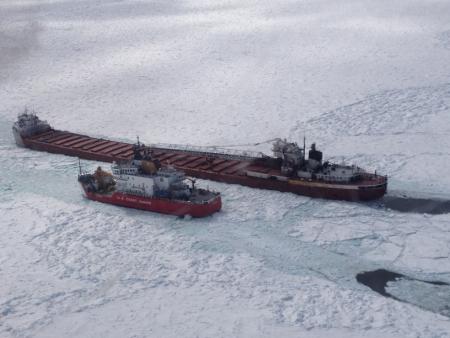The following is the text of a news release from the U.S. Coast Guard:
(SAULT STE. MARIE, Mich.) — Coast Guard crews concluded the nation’s largest domestic ice operation, known as Taconite, on Thursday after more than five months of icebreaking operations in the northern Great Lakes.
Coast Guard Sector Sault Ste. Marie plans and runs Operation Taconite, which includes all of Lakes Superior and Michigan, the northern half of Lake Huron, the St. Marys River and the Straits of Mackinac.
During the 160 days of the operation, nine U.S. Coast Guard and three Canadian Coast Guard icebreakers spent more than 5,000 hours breaking ice for convoys and assisted in 946 commercial vessel transits that moved an estimated 33 million tons of dry bulk and liquid cargoes, valued at $1.2 billion. These commodities were crucial to sustaining industrial production and power generation for the Great Lakes region during the winter months. Icebreakers provided direct assistance for 517 of the transits.
An additional 5,597 hours of ice breaking established and maintained tracks through the ice-choked waterways of Georgian Bay, Straits of Mackinac, Green Bay, southern Lake Michigan, St. Marys River, and across Lake Superior.
U.S. and Canadian Coast Guard aviators flew 43 sorties in direct support of the icebreaking operation, providing a bird's-eye view of ice coverage, track quality and open water.
Although official statistics have not been released, it is reported the 2013-14 winter season produced the thickest and most expansive ice cover the Great Lakes has experienced in 35 years.
Icebreaking crews experienced the dramatic conditions firsthand. In February 2014, the crew of Coast Guard cutter Katmai Bay spent eight days escorting the motor tanker Algocanadas up the St. Marys River, a transit that takes 12 hours under historical ice conditions. Katmai Bay’s crew had to stop the escort twice to refuel.
In March, the crew of Coast Guard cutter Mackinaw, the Coast Guard’s most powerful icebreaker in the Great Lakes, led the tug Joyce L. Van Ekenvort with barge Great Lakes Trader on the season's first westbound crossing of the Straits of Mackinac. The typically 12-hour voyage lasted four days. The Joyce L. Van Ekenvort is the most powerful tugboat on the Great Lakes.
The crew of Mackinaw also led the first eastbound crossing of Lake Superior. Their voyage lasted nine days, though it usually takes 24 hours.
The first load of iron ore, from Two Harbors, Minn., to Gary Harbor, Ind., took 13 days to deliver, which is normally a three-day voyage.

